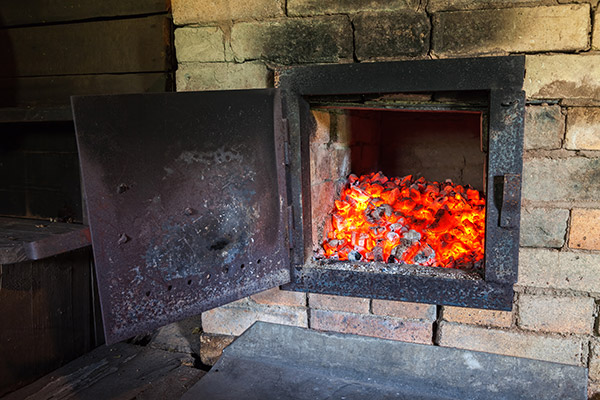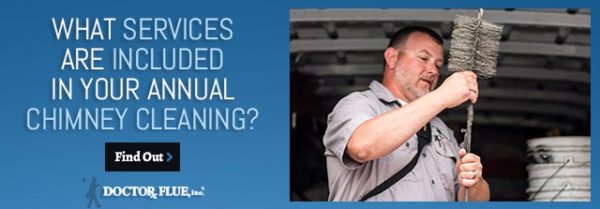
Temperatures are dropping and many homeowners are starting to think about their fireplaces for the cold season. But if they haven’t had their chimney cleaned recently, there may be a hidden danger lurking in the deepest reaches of their flues: creosote. What is creosote? It’s a dangerous byproduct that comes from burning wood and stays in your chimney until it’s removed. Learn about the dangers of creosote and what you can do to fight it.
So, Exactly What Is Creosote?
When you burn wood or fossil fuels, your goal is to burn them as completely as possible. However, if the airflow to your fire isn’t adequate, it essentially starves the fire – leading to incomplete combustion. When the oils in the wood aren’t completely burned, they off-gas as volatiles and travel up through the smoke. The smoke cools as it rises, and ultimately condenses with water and other chemicals on the interior of your chimney and flue. This residue is called creosote.
Creosote in your chimney has three different stages:
Stage 1 – Creosote begins as a loose, flaky deposit that can be easily brushed away.
Stage 2 – Then it turns into a tar-like deposit which can be difficult to remove, often requiring specialized brushes or scrapers.
Stage 3 – The creosote becomes hardened and is much more difficult to remove. At this stage, it will also begin to drip like candlewax when it reaches a high enough temperature.
What Causes Creosote Buildup?
To safely burn a fire in your home, you use a fireplace or a wood stove. These, in turn, use the flue and chimney to evacuate the heat and smoke safely out of your home. While these appliances are designed specifically for fires, they do have one side-effect: they constrain airflow.
Because a fireplace or chimney can prevent adequate airflow, creosote is created and begins building up. However, this is a compounding problem. The creosote that condenses and remains on your flue slowly begins to restrict the airflow even more. As time goes on, creosote deposits cause more significant issues with incomplete combustion, leading to faster buildup of creosote.
These deposits can grow to cover the inside of your chimney more quickly than you think. Even small amounts of incomplete combustion can begin this process, which means almost any home will have creosote in the chimney. If you haven’t had your chimney inspected recently, you probably have some visible deposits right now!
Why Is Creosote Dangerous?
Creosote does a lot more than simply reduce the airflow of your chimney. It’s dangerous to your health and your home:
Creosote is Toxic
Exposure to creosote can have a wide-range of effects on your health. While some are simply irritating, other effects can be severe. Here are some of the most common symptoms associated with creosote exposure:
Irritated Skin – If you come into physical contact with creosote, you may notice rashes or other reactions.
Irritated Eyes – Creosote can cause sensitivity to light or even symptoms that mirror chemical burns in your eyes. This risk is why you should always rely on an expert to safely clean your chimney.
Respiratory Issues – Unsurprisingly, if you breathe in creosote particles, you’re very likely to develop respiratory issues over time.
Cancer – Even in homes with poorly maintained chimneys, it’s unlikely that you’ll have enough creosote exposure to lead to cancer. However, studies have shown that creosote is carcinogenic, so long-term exposure is a risk.
If you rent out a property with a masonry chimney, like many of the landlords in the Bowling Green, Ohio area, creosote exposure from a poorly-maintained fireplace could put your tenants at risk. This, in turn, puts you at risk for complaints or possible legal action!
It’s Also a Fire Hazard
What is creosote doing in your chimney? Waiting to be burned! Being toxic to your health isn’t the most concerning risk of creosote. It’s also one of the leading causes of chimney fires across the globe. The deposits that are left in your chimney are flammable, and when it ignites it creates a scorching hot fire.
Unfortunately, while you may think of a fireplace or chimney as an appropriate location for a fire, chimney fires are dangerous. The masonry and flue lining are only designed to handle certain levels of heat, and the intense nature of chimney fires exceeds that limit. While no visible damage may be noticeable after your first chimney fire, it weakens your homes ability to withstand a second one. If you have a chimney fire, the chimney lining will be almost certainly damaged beyond repair and in need of replacement.
A chimney fire can easily ignite anything combustible within reach of its heat. While your chimney may be made of bricks, your home likely has wood-beams and other supporting structures nearby that can catch fire. If you suspect you’ve had a chimney fire or at risk, you should contact a CSIA-certified chimney sweep to inspect your chimney immediately.
How Do I Get Rid of Creosote?
The safest and most reliable way to remove creosote is to call a professional. While it’s not impossible to remove creosote yourself, it’s not safe for the average homeowner. Creosote can be a health hazard, and the buildup is usually near the top of your flue where the smoke has had a chance to cool and condense – which is difficult to clean without the right tools and safety training.
Some homeowners turn to creosote sweeping logs to help reduce creosote buildup. These can help you remove some creosote from your chimney but they will never remove it all. However, depending on the stage and severity of your creosote problem, they may not help at all. Remember that even if you use creosote sweeping logs early and often, they cannot replace a thorough chimney sweeping!
Stay Safe by Burning Smart
The best way to reduce your creosote buildups is by burning the right fuel. For your wood-burning appliances, that means exclusively burning dry, seasoned wood. These logs will burn more completely and have fewer byproducts. By comparison, green wood has a higher moisture content that creates smoky fires and increases the amount of incomplete combustion. And it should go without saying that you should never burn anything but wood in your wood-burning stove or fireplace.
Worried About Creosote Buildup? Call Doctor Flue!
If you think your fireplace or chimney may have creosote deposits Contact us today! Doctor Flue offers chimney services in Michigan and Ohio and can inspect your chimney and identify any potential risks. We’ll get you set up right away so you can have peace of mind.
Call Us: 1-800-438-3583
Email Us: office@drflue.com
Office Hours: Mon-Fri: 8am-4pm
Connect with Doctor Flue on Social Media

